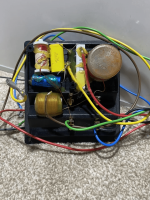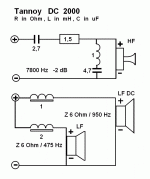I see crossover circuit has two 1mH inductors with same inductance but different DCR wired in seriesvfor high pass filtering. What are the advantages?
Would one single 2mH inductor do a better job?
Would one single 2mH inductor do a better job?
Best post the crossover circuit so we can be sure of the positions of the two inductors within it.
Hi sorry to jump in with a question instead of an answer
Can a sim software provide any information ?
Can a sim software provide any information ?
Two identical 1mH inductors in series will add up to greater resistance that one 2mH inductor wound from the same wire.
two 1mH inductors ... wired in series for high pass filtering.
I see no series inductors anywhere in the above Tannoy crossover.
The two 1mH coils in series will get you 2mH so long as they are not oriented w.r.t each other such that their magnetic fields can interact. Why not just go with a 1mH coil and be done with it? If the series resistance needs to match what the 2mH coil had, just pad the resistance of the 1mH coil with a bit of series R as needed.
I have no idea what you're talking about. The diagram you put up is for Tannoy DC2000 speakers, which have a dual concentric driver and, in addition, a separate woofer. The diagram shows a 1mH inductor in series with the LF of the dual concentric, and a 2mH inductor in series with the separate woofer.
Why would they use iron cores in series and air core for shunting, when the values are what they are?
If you plan to use two in series it makes sense to take advantage of this. The two 1mH inductors are too large to use in this situation but you could combine one with another smaller one. You end up with a reduced resistance and you can trim the inductance simply over a range.that their magnetic fields can interact
I sent the stock crossover as the picture shown to the parts vendor and they measure the dcr for me and selected the proper one from the Jantzen catalog.
And the local builder will take care everything.
Thanks you very much for all of you 🙏
And the local builder will take care everything.
Thanks you very much for all of you 🙏
To keep the dcr low on the series inductors, surely. Pretty standard. If the OP wants to upgrade the parts, though, heavier gauge air core would be the obvious way to go.Why would they use iron cores in series and air core for shunting, when the values are what they are?
The diagram posted by the OP does not have two inductors in series with each other.If you plan to use two in series it makes sense to take advantage of this...
True, perhaps I misunderstood something.. but it's good to know. I've been known to use a pair intentionally, where one would do, so I could adjust the value without unwinding either of them.
Why would they use iron cores in series and air core for shunting, when the values are what they are?
Isn't the resistance of the air core inductor in the HF section necessary to the function of the series notch filter?
And just to emphasise once again, there is an iron core inductor in series with each bass driver, but nowhere in the schematic are there two inductors in series with each other.
I see crossover circuit has two 1mH inductors with same inductance but different DCR wired in series ... for high pass filtering.
(That's my emphasis in the above transcription.)
Tubenstein's opening description bears no relation to the Tannoy crossover schematic he provided.
Colour me puzzled as to what he is trying to achieve!
If, by necessary, you mean that the resistance contributes to the damping of the circuit, then yes, it does.. but if by necessary you meant that it has to be resistance in the wire of the coil proper, then no, it doesn't.Isn't the resistance of the air core inductor in the HF section necessary to the function of the series notch filter?
- Home
- Loudspeakers
- Multi-Way
- inductor in series or not

